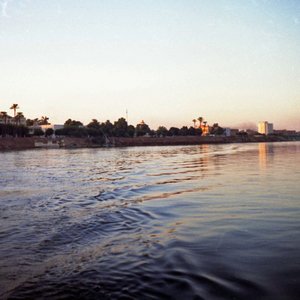Advertisement
Published: September 10th 2019

 Crossing the Nile
Crossing the Nile
Crossing the Nile from Luxor to the Valley of the Kings.
Egypt013pIn the morning we boarded a ferry to take us across the Nile from Luxor to the Valley of the Kings. In the Valley we entered several of the tombs, including King Tut's tomb and the tomb of Rameses VI (d. 1137 BC). I think the tomb that stands out the most now is that of Rameses VI. The decorated walls with multitudes of painted figures depicting Egyptian theology and myths were a fantastic sight.
Our guide through the Valley was excellent. He was very knowledgeable about Egyptian archaelology and history and eager to tell the story. At the tomb of Rameses VI, he explained in detail the paintings depicting the Egyptian myth of the day and night. The sky goddess Nut swallows the sun and then gives birth to it the following morning. The painting showed the goddess Nut with a very elongated body to enable the sun to make its nocturnal journey through her. The story has parallels with the Egyptian theology of birth, death and afterlife. The guide fell silent at one point when another group drew near. He later explained he did not want to embarass the other guides by his knowledge or make the visitors

 Colossi of Memnon
Colossi of Memnon
Valley of the Kings: Colossi of Memnon dating to 1350 BC. I remain very impressed by the 60 foot (18 m) tall Colossi of Memnon, each representing Amenhotep III (14th century BC). The statues are made from blocks of quartzite sandstone quarried near present-day Cairo.
Egypt023afeel they were being shortchanged on information. (Was he being nice, or did he just not want to give out freebie information? Who knows.)
At the end of the tour, we saw Deir el Bahari, the mortuary temple of Queen Hatshepsut (1507–1458 BC), built at the base of a cliff. On the way out of the Valley, I was very impressed by the 60 foot (18 m) tall Colossi of Memnon, representing Amenhotep III. It's one of the enduring memories of the visit to the Valley of the kings.
We returned to Luxor and headed for the airport. While we waited on the tarmac for our flight to arrive, an older man dressed in robes and headgear worked the queue of passengers. He was seeking "baksheesh", or some form of chit or recommendation from anyone queued up for the plane. I may have given him some loose coins. He was proud to display an expired bright yellow Northeast Airlines plastic credit card someone had given to him. That seemed to be more in line with what he sought, not money. Why did he want more cards like that? I've never forgotten that encounter.
Advertisement
Tot: 0.057s; Tpl: 0.011s; cc: 12; qc: 28; dbt: 0.0294s; 1; m:domysql w:travelblog (10.17.0.13); sld: 1;
; mem: 1.1mb

 Crossing the Nile
Crossing the Nile
 Colossi of Memnon
Colossi of Memnon 






